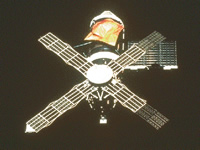|
| |
 |
|
 |
|
 |
|
 |
|
| |
Beginnings
|
|
Moon Landing
|
|
Skylab
|
|
Columbia
|
|
| |
1 of 4
|
|
2 of 4
|
|
3 of 4
|
|
4 of 4
|
|
| |
3 mins 8 secs
|
|
2 mins 29 secs
|
|
2 mins 38 secs
|
|
4 mins 6 secs
|
|
| |
This is a Four Part - 12 minute
21 second video clip - Click on each section in turn to watch in order...
|
|
|
 |
|
Skylab. America's
first experimental space station. Designed for long duration
missions, Skylab program objectives were twofold: To prove
that humans could live and work in space for extended
periods, and to expand our knowledge of solar astronomy
well beyond Earth-based observations. |
|
Second by second breakdown and analysis
of the video clip
0:00 - 0:20
May-November 1973
With its array of solar telescopes, Skylab is NASA's first space
station.
0:20 - 1:00
A guided tour of Skylab is aided by its weightless conditions.
1:00 - 1:13
Skylab is far more spacious than later space stations.
1:13 - 1:25
Spacewalks provide a unique sightseeing opportunity.
1:25 - 2:13
17 July 1975
Historic space link-up, between an Apollo capsule and a Soviet Soyuz
module.
2:13 - 2:38
Soviet cosmonauts welcome the Americans aboard.
Want to comment on this
video clip? Send us an e-mail and we'll
publish your most interesting views on our comments
page.
Technical
Note - This
video clip is encoded in Windows Media Format, and you may need
to download a player which you can get here.
Each video clip is presented in four file sizes to accommodate all
connection speeds. Click on the most appropriate (Clicking on the
picture is 450k) The windows media player should open automatically
and start to play after a brief buffering period. Enjoy!
|
56k |
For
normal 28k and 56k modems. (Smallest file size) |
| 100k |
For
dual ISDN connections |
| 300k |
For
slower ADSL or cable connections. |
| 450k |
Broadband
(Biggest file size) |
|
